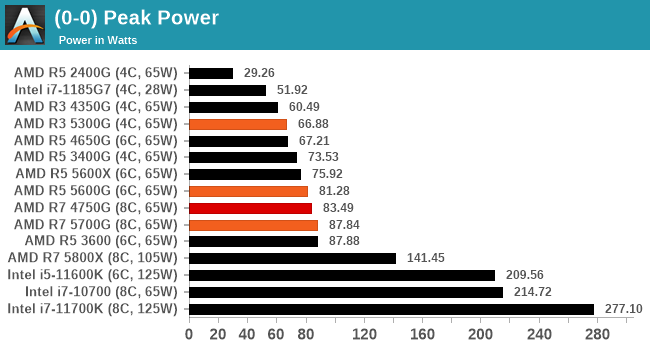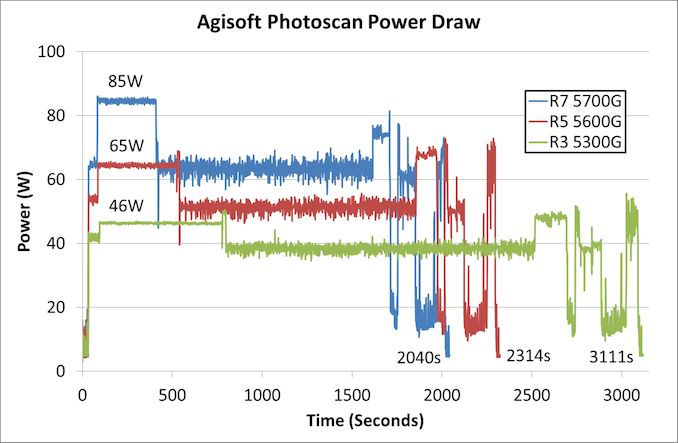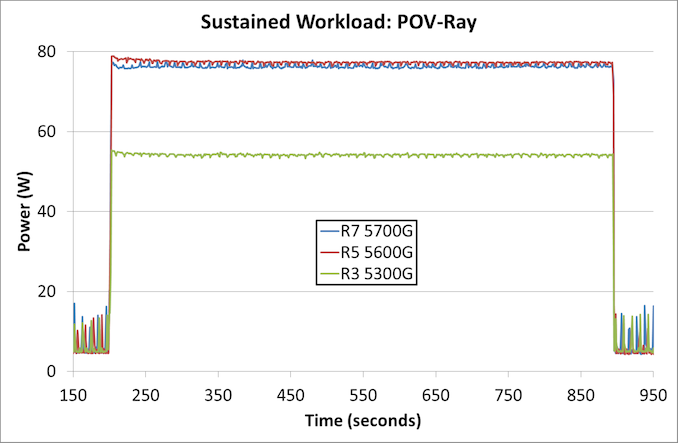The AMD Ryzen 7 5700G, Ryzen 5 5600G, and Ryzen 3 5300G Review
by Dr. Ian Cutress on August 4, 2021 1:45 PM ESTPower Consumption
The nature of reporting processor power consumption has become, in part, a dystopian nightmare. Historically the peak power consumption of a processor, as purchased, is given by its Thermal Design Power (TDP, or PL1). For many markets, such as embedded processors, that value of TDP still signifies the peak power consumption. For the processors we test at AnandTech, either desktop, notebook, or enterprise, this is not always the case.
Modern high-performance processors implement a feature called Turbo. This allows, usually for a limited time, a processor to go beyond its rated frequency. Exactly how far the processor goes depends on a few factors, such as the Turbo Power Limit (PL2), whether the peak frequency is hardcoded, the thermals, and the power delivery. Turbo can sometimes be very aggressive, allowing power values 2.5x above the rated TDP.
AMD and Intel have different definitions for TDP, but are broadly speaking applied the same. The difference comes to turbo modes, turbo limits, turbo budgets, and how the processors manage that power balance. These topics are 10000-12000 word articles in their own right, and we’ve got a few articles worth reading on the topic.
- Why Intel Processors Draw More Power Than Expected: TDP and Turbo Explained
- Talking TDP, Turbo and Overclocking: An Interview with Intel Fellow Guy Therien
- Reaching for Turbo: Aligning Perception with AMD’s Frequency Metrics
- Intel’s TDP Shenanigans Hurts Everyone
In simple terms, processor manufacturers only ever guarantee two values that are tied together - when all cores are running at base frequency, the processor should be running at or below the TDP rating. All turbo modes and power modes above that are not covered by warranty. Intel kind of screwed this up with the Tiger Lake launch in September 2020, by refusing to define a TDP rating for its new processors, instead of going for a range. Obfuscation like this is a frustrating endeavor for press and end-users alike.
However, for our tests in this review, we measure the power consumption of the processor in a variety of different scenarios. These include workflows, real-world image-model construction, and others as appropriate. These tests are done as comparative models. We also note the peak power recorded in any of our tests.
First up is our image-model construction workload, using our Agisoft Photoscan benchmark. This test has a number of different areas that involve single thread, multi-thread, or memory limited algorithms.
For the Ryzen 7 5700G, the most power-hungry part of the test is right at the beginning, where we’re seeing peaks of 85 W. For the 5600G, that first section goes to 65 W, but the peaks actually occur here near the end of the test. The 5300G also has peaks later in the test, but that first section is the lowest, running only at 46 W.
The second test is a sustained rendering workload.
In this instance, the Ryzen 3 5300G is nearer 55 W with a sustained workload over 10 minutes, while the Ryzen 5 and Ryzen 7 sit just below 80 W.
For peak power, we report the highest value observed from any of our benchmark tests.

While all three processors have a TDP rating of 65 W, by default on AMD systems the Package Power Tracking, which is the limiting factor here, is 88 W. The Ryzen 7 is practically at that value, while the Ryzen 5 just goes a smidge over 80 W. The Ryzen 3 on the other hand only matches its TDP in the worst-case scenario.












135 Comments
View All Comments
Cooe - Friday, August 6, 2021 - link
The recent GPU driver additions were NOT for Rembrandt. My guess is that's from some as of yet unannounced custom/embedded part for a market/use case where die size is absolutely CRITICAL (the only reason to pick RDNA over RDNA 2 is raw transistor density), that we're seeing there. Rembrandt otoh has had explicitly "RDNA 2" based graphics IP literally since it very first appeared on leaked AMD roadmaps YEARS ago, and it's consistently stayed "RDNA 2" in every future appearance/leaked roadmap.In fact with AMD's penchant for copy-pastaing reusable IP blocks across as many different products as they can, the iGPU implementation on Rembrandt is likely to be EXTREMELY similar to what is currently seen on Van Gogh (in fact, it wouldn't surprise me at ALL if they end up just sharing the exact same 8CU RDNA 2 iGPU block wholesale).
nandnandnand - Saturday, August 7, 2021 - link
https://www.notebookcheck.net/AMD-Ryzen-6000-Rembr..."Van Gogh is said to have eight compute units (CUs) per shader array with a 1 MB L2 cache while Rembrandt will have six CUs per shader array with 2 MB L2 cache, with the added cache possibly translating into improved gaming performance. It must be noted here that we still do not know the total number of CUs on the GPU, but rumors indicate up to 12 CUs for Rembrandt."
AThomas - Wednesday, August 4, 2021 - link
These APU's have my exact use case. Upgrading my HTPC which has trouble with HEVC codec (YouTube 4K) that can easily play PS2, PS1, Dreamcast, Sega 32X/CD, etc, etc. Plus Space Engineers which none of my rigs can play at the moment. All done with the iGPU at 60+FPS or better , also some Xbox titles like Forza Horizon since I don't play on buying a Xbox X.Second use is server. WIth a couple of VM's but mostly containers. Maybe throw a GPU in their for renting out GPU. All those threads will allow lots of functional task to be done.
Jorgp2 - Thursday, August 5, 2021 - link
AMDs APUs don't support GPU virtualizationGreenReaper - Sunday, August 15, 2021 - link
Not yet, no.boozed - Wednesday, August 4, 2021 - link
Are you sure?eastcoast_pete - Thursday, August 5, 2021 - link
Hush now! Ian was spilling Intel's newest acquisition plans..ballsystemlord - Wednesday, August 4, 2021 - link
In addition to what Dan said above your table entitled, "Ryzen 5 APUs (65W)" Is completely wrong. The 5600G is a 6 core processor and I suspect some of the other entries are incorrect also.Rudde - Wednesday, August 4, 2021 - link
"The second part is a Ryzen 5 5600G, featuring six cores and sixteen threads, with a base frequency of 3.9 GHz and a turbo frequency of 4.6 GHz. "This sentence has suffered from some copy and pasting. 12 threads and 4.4 GHz boost.
nandnandnand - Wednesday, August 4, 2021 - link
"However slow quad cores (like the 2400G still let you down."Missing closing parenthesis mark.